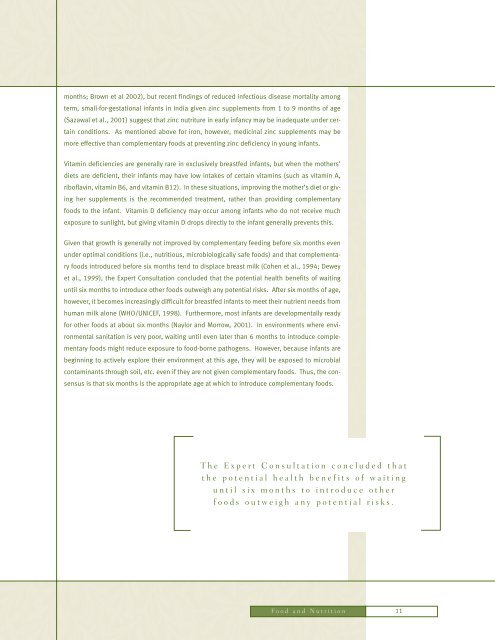Guiding Principles for Complementary Feeding of the Breastfed
Guiding Principles for Complementary Feeding of the Breastfed
Guiding Principles for Complementary Feeding of the Breastfed
You also want an ePaper? Increase the reach of your titles
YUMPU automatically turns print PDFs into web optimized ePapers that Google loves.
months; Brown et al 2002), but recent findings <strong>of</strong> reduced infectious disease mortality among<br />
term, small-<strong>for</strong>-gestational infants in India given zinc supplements from 1 to 9 months <strong>of</strong> age<br />
(Sazawal et al., 2001) suggest that zinc nutriture in early infancy may be inadequate under certain<br />
conditions. As mentioned above <strong>for</strong> iron, however, medicinal zinc supplements may be<br />
more effective than complementary foods at preventing zinc deficiency in young infants.<br />
Vitamin deficiencies are generally rare in exclusively breastfed infants, but when <strong>the</strong> mo<strong>the</strong>rs’<br />
diets are deficient, <strong>the</strong>ir infants may have low intakes <strong>of</strong> certain vitamins (such as vitamin A,<br />
rib<strong>of</strong>lavin, vitamin B6, and vitamin B12). In <strong>the</strong>se situations, improving <strong>the</strong> mo<strong>the</strong>r’s diet or giving<br />
her supplements is <strong>the</strong> recommended treatment, ra<strong>the</strong>r than providing complementary<br />
foods to <strong>the</strong> infant. Vitamin D deficiency may occur among infants who do not receive much<br />
exposure to sunlight, but giving vitamin D drops directly to <strong>the</strong> infant generally prevents this.<br />
Given that growth is generally not improved by complementary feeding be<strong>for</strong>e six months even<br />
under optimal conditions (i.e., nutritious, microbiologically safe foods) and that complementary<br />
foods introduced be<strong>for</strong>e six months tend to displace breast milk (Cohen et al., 1994; Dewey<br />
et al., 1999), <strong>the</strong> Expert Consultation concluded that <strong>the</strong> potential health benefits <strong>of</strong> waiting<br />
until six months to introduce o<strong>the</strong>r foods outweigh any potential risks. After six months <strong>of</strong> age,<br />
however, it becomes increasingly difficult <strong>for</strong> breastfed infants to meet <strong>the</strong>ir nutrient needs from<br />
human milk alone (WHO/UNICEF, 1998). Fur<strong>the</strong>rmore, most infants are developmentally ready<br />
<strong>for</strong> o<strong>the</strong>r foods at about six months (Naylor and Morrow, 2001). In environments where environmental<br />
sanitation is very poor, waiting until even later than 6 months to introduce complementary<br />
foods might reduce exposure to food-borne pathogens. However, because infants are<br />
beginning to actively explore <strong>the</strong>ir environment at this age, <strong>the</strong>y will be exposed to microbial<br />
contaminants through soil, etc. even if <strong>the</strong>y are not given complementary foods. Thus, <strong>the</strong> consensus<br />
is that six months is <strong>the</strong> appropriate age at which to introduce complementary foods.<br />
The Expert Consultation concluded that<br />
<strong>the</strong> potential health benefits <strong>of</strong> waiting<br />
until six months to introduce o<strong>the</strong>r<br />
foods outweigh any potential risks.<br />
Food and Nutrition<br />
11

















